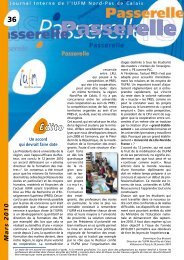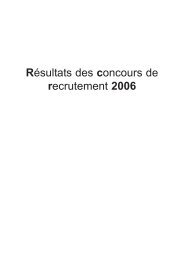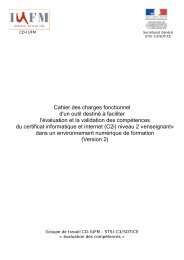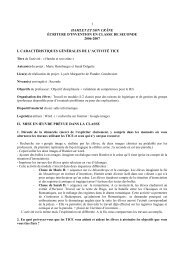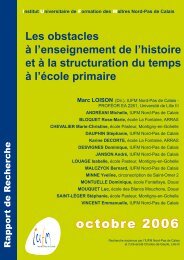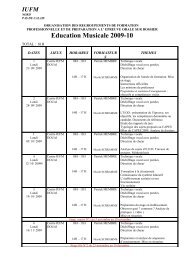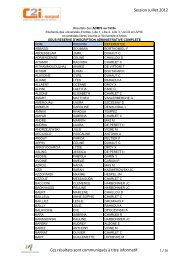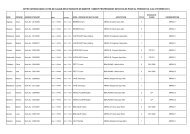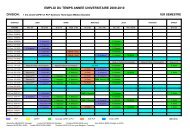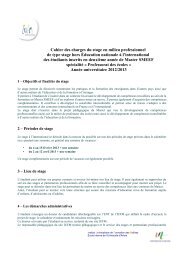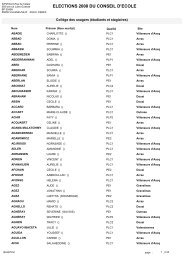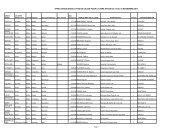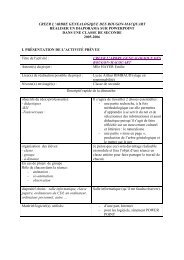Create successful ePaper yourself
Turn your PDF publications into a flip-book with our unique Google optimized e-Paper software.
criteria).<br />
3.2. Characteristic abilities<br />
S.I.A. makes it possib<strong>le</strong> to perceive the cases where characteristics are those of a part<br />
of the group of pupils studied, compared to a group where all the pupils of the group were<br />
studied. They “almost” all share the same characteristics, contrary to the modes of analysis<br />
which produce symmetrical links. We will start by presenting a case where a characteristic<br />
comes up as specific to one of the groups.<br />
The examp<strong>le</strong> is that of the characteristic “writing a text using “I” which is the characteristic of<br />
one of the classes coded CM1WB.<br />
– (1) “Writing a text using “I”” implies “belonging to class CM1 WB” (99%)<br />
Only the pupils of this class chose a particular writing behaviour, which indicates that pupils<br />
read into a suggested situation an evaluation situation : the expected reader is the teacher<br />
and pupils show what they can do. But what seems even more important is the fact that<br />
the implicative link of maximal intensity means that no pupil “or rather almost none” in other<br />
classes have reacted in that way. To explain this specificity, we venture the hypothesis that<br />
the way the task was done has been singularized in class : maybe only this CM1 teacher<br />
has presented the exercise as an evaluation, or at <strong>le</strong>ast like an exercise that he would check<br />
on.<br />
3.3. Groups characterized by capacities<br />
On the other hand, other implicative links show that almost all pupils of a same class share<br />
some skills and also make the same mistakes etc. Let’s keep in mind some of them :<br />
(95%)<br />
–<br />
–<br />
(1) “Belonging to CM2H03” implies “using “tu””(90%)<br />
(2) “Belonging to CM2WB” implies “Mentioning point 0 and changing its status”<br />
This time, these characteristics are met in almost all the pupils of a same class.<br />
We think that they are the results – sometimes indirect – of the didactical or pedagogical<br />
ways used in class. What is <strong>le</strong>ft is to interpret these different ru<strong>le</strong>s. If almost all the pupils<br />
of the first particularized class address a reader who acts like “a peer” in their writings, it is<br />
no doubt because help and cooperation are <strong>le</strong>gitimized and encouraged in these classes or<br />
because these forms of communication are used. If almost all the pupils of the second class<br />
show good geometrics skills, it is no doubt thanks to the teaching techniques used.<br />
But this geometrics skill cannot be understood without linguistic skills which make it<br />
possib<strong>le</strong> to communicate it. Using “tu” (informal “you”) is not always the required school<br />
form required. Now, these two classes have pupils from different social backgrounds :<br />
in the second class the pupils come from more privi<strong>le</strong>ged families than the other studied<br />
classes. Relationships between social classes and linguistic ways are certainly comp<strong>le</strong>x<br />
and not mechanical. However, the results we are getting are coherent with those of other<br />
studies on these relations. As a consequence, we cannot neg<strong>le</strong>ct the explicative factor of<br />
cohesion between observed behaviours. We are bumping here into a recurrent prob<strong>le</strong>m : the<br />
princip<strong>le</strong>s of subjects’ categorisation are obviously never unique or uniform. The gatherings<br />
of pupils in this particular case cover both institutional groups (school classes) and “social”<br />
116<br />
<strong>IUFM</strong> Nord-Pas de Calais




